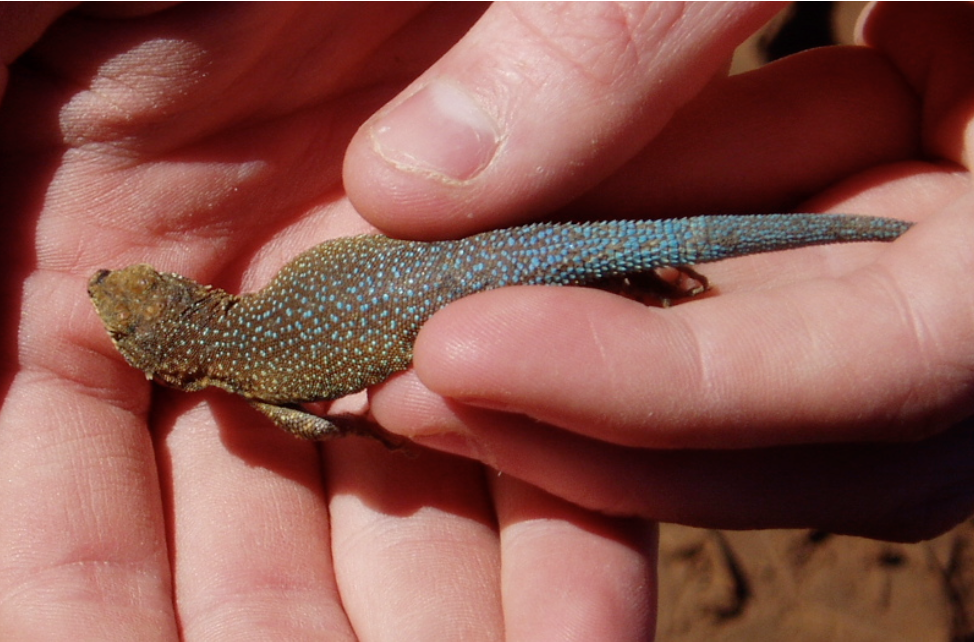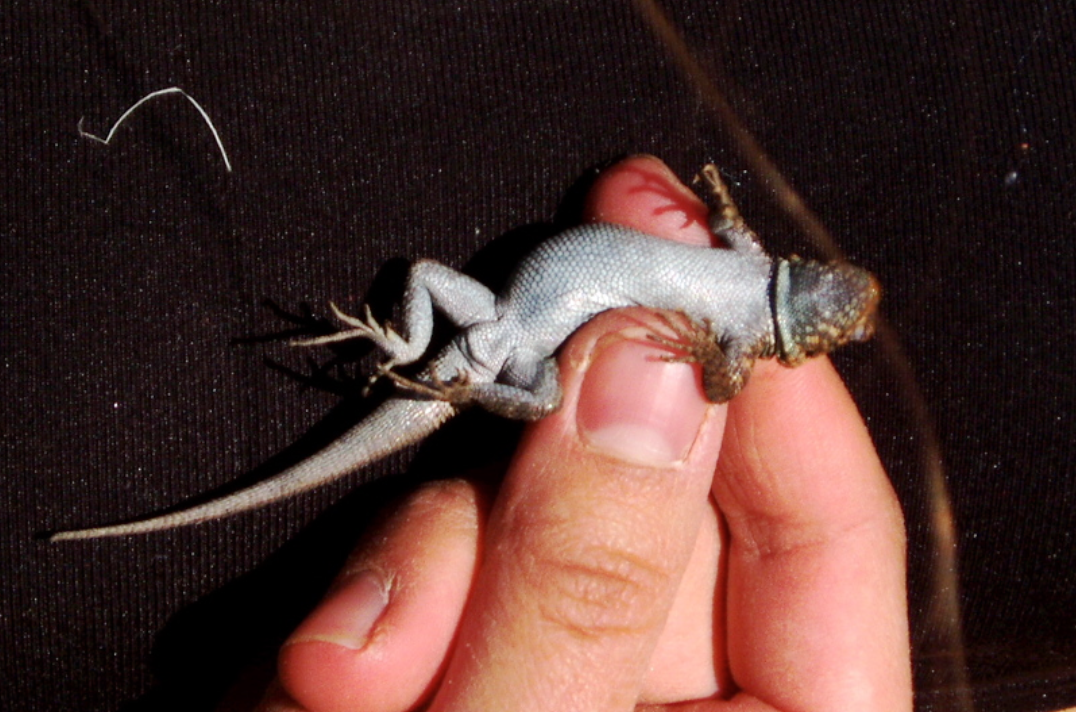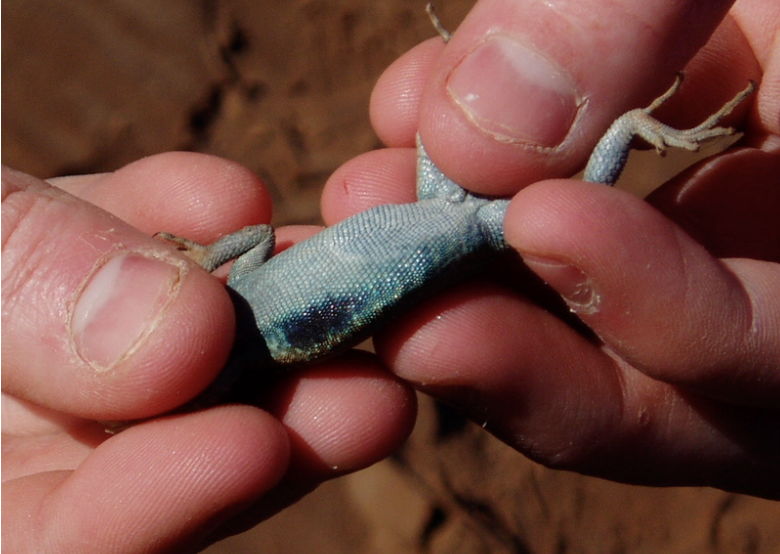The side-blotched lizard (Uta stansburiana) is one of the most common lizards along the Colorado River corridor through the Grand Canyon (Warren and Schwalbe 1986). During our trip down the river, we saw numerous side-blotched lizards, despite the cold spring weather; they were by far the most frequently observed lizard species. Their colors were variable and bright, including shades of brown, gray, white and blue dorsally; with whites, blues, oranges, and yellows ventrally (Fig. 1 and 2). Past studies have shown that these lizards are most abundant in the lower riparian zones (new high water zone and fluctuation zone) (Warren and Schwalbe 1986); however we found that they were widespread throughout the riparian zone, and even above the riparian corridor. Our qualitative observations suggest that the side-blotched lizard may not rely as heavily on the lower riparian zones as past studies suggest, but rather that it utilizes all parts of the riparian habitat. In fact, these lizards seemed to possess a broad habitat preference, and were found practically everywhere we went in the canyon.


Stebbins (2003) acknowledges that side-blotched lizards use various habitats throughout their range, and indicates that sand, rock, grass, shrub, and trees all provide suitable environments. We found that rocky areas appeared to be the favorite habitat of side-blotched lizards in the Grand Canyon. Few lizards were spotted in sandy areas that lacked rocks, even if vegetation was present. In contrast, canyon washes that had rocky habitat as a result of past debris flows contained numerous side-blotched lizard individuals. The reliance of these ectothermic lizards on some sort of rocky habitat is logical because rocks provide a perch for basking in the sun, which allows them to warm their bodies up during the day. Rocks also provide cover and feeding perches, although vegetation can be used for these needs as well. The presence of vegetation and the river itself are also important for these lizards because they promote insect populations. Side- blotched lizards feed solely on insects (Stebbins 2003), and therefore rely on habitat that can also house insects. The river corridor and nearby washes effectively supply abundant food and structurally complex habitat for side-blotched lizards.
This small lizard can be identified by the bluish-black blotch on either side of its chest, located just behind the forelimb (Fig. 3) (Stebbins 2003). Males and females differ in color, with females being much paler. There is also a variety of male coloration patterns that are related to an interesting breeding system. We observed several individuals in order to examine the coloration of male side-blotched lizards within the Grand Canyon. The throat color of the male lizards varied between orange, blue, and yellow (Fig 4). Barry Sinervo, a professor at the University of California, Santa Cruz, has conducted extensive research on the breeding colors of side-blotched lizards. He describes this breeding pyramid as an evolutionary game of “rock-paper-scissors” between various breeding strategies signified by their colors (Sinervo and Lively 1996).

Orange, “ultra-dominant”, males are territorial. An orange male maintains a harem of many females and mates freely with any female within his territory (Sinervo and Lively 1996). This strategy is not without its shortcomings. Because the orange males’ territory is so extensive, a single male cannot defend every female within his harem. Males that possess yellow coloration are known as “sneaker” or polygamous males. These yellow males literally sneak into the orange male’s territory and copulate with one of his protected females while the orange male is copulating with a different female or otherwise distracted (Sinervo and Lively 1996). There is yet another strategy among side- blotched males. Blue colored males are “mate guarding” and use a monogamous mating strategy. Blue males are neither polygamous like yellow males, nor territorial, like orange males. However, if challenged by an orange male, the blue male is subordinate, and will be forced to forfeit his female to the dominant male’s harem (Sinervo and Lively 1996).
This circular, evolutionary arms race represents an incredibly interesting evolutionary and ecological pattern that is unique to the most common species of lizard we observed in the Grand Canyon.

REFERENCES
Dettman, J.A. 2005. “Glen Canyon Dam: A mixed blessing for mammals, reptiles, and amphibians?” In. J. Mount, P. Moyle and C. Hammersmark (eds.). Ecogeomorphology of the Grand Canyon and its Tributary Streams. Davis, CA.
Sinervo, B. and Lively, C.M. 1996. The rock-scissors-paper game and the evolution of alternative male strategies. Nature 340:240-246.
Stebbins, R. C. 2003. Western Reptiles and Amphibians, Peterson Field Guide. Houghton Mifflin Company, Boston, New York, USA.
Warren, P. L., and C. R. Schwalbe. 1988. Lizards along the Colorado River in Grand Canyon National Park: Possible effects of fluctuating river flows. Glen Canyon Environmental Studies Executive Summaries of Technical Reports. US Dept. of the Interior, Bureau of Reclamation, Geological Survey, National Park Service.
